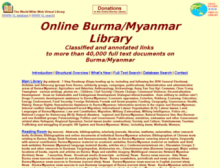Resource information
Summary:
"Wrong-headed agricultural and development policies, counter-insurgency activities, as well
as corruption and cronyism by the Burmese military regime, have all caused a dramatic
decrease in rice production and food security in southern Shan State over the past ten years.
The township of Mong Nai provides a good example of how food security, commonly defined
as the physical and economic access to sufficient, safe and nutritious food at all times, has
been put in a precarious condition despite the regime’s claims that it is achieving self-sufficiency
and agricultural development. In the past Mong Nai was well known for its fertile land and
abundant production of quality rice. Even though people could not make much income from
their crops, they had enough to survive. Since 1994, however, a series of national policies and
initiatives have led to a decline in rice production, the abandonment of fertile fields, and the
exodus of thousands of residents to neighbouring Thailand.
In order to implement its national rice procurement policy, the State Peace and Development
Council (SPDC) set up a paddy (unmilled rice) buying center in the town of Mong Nai in
1994. Farmers were forced to sell rice to the regime at depressed prices (about one quarter
of the normal market price) based on the acreage of land they customarily tended and regardless
of actual crop yields. This center, and how its quota system was implemented, disrupted
farmers’ access to their own rice harvests and drove many into debt. The SPDC proudly
announced the abolishment of this system and the opening of a market-oriented economy in
2003. However, new practices have been able to ensure that the military maintains its own
stores of rice at the expense of local populations. agriculture, and led to decreased rice production and food security in the township. The
amount of rice fields under cultivation has decreased by approximately 56% since 1994
while the population has decreased by approximately 30%. The drastic decrease in upland
agriculture has practically wiped out the cultivation of sesame and the subsequent production
of sesame oil in the township, while a wide variety of beans, fruits, and other vegetables are
also not cultivated. Restrictions on trade and travel have made foodstuffs harder to get and
more expensive.
Contrary to the regime’s claims, Burma is not on the road to self-sufficiency and food security."...
Table of Contents:
Summary.2;
Background 4;
Food and Agriculture Situation Before 1994 5;
Rice Procurement Policy/the Quota System 6;
Forced Relocation 7;
Map 1: Rice Cultivation and Villages in 1994 8;
Map 2: Rice Culitvation, Remaining Villages and Confiscated Lands in 2005 9;
Land Confiscation 10;
Restricted Movement 12;
Trading Restrictions 13;
Forced Planting of Summer Paddy 13;
Conclusion: The Situation Today 15...
Appendix 1: Decrease in Rice Production in Mong Nai Township 1994-2005 16.


